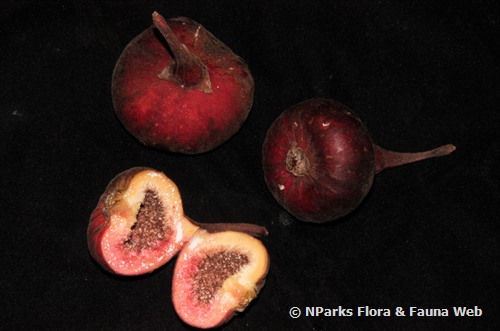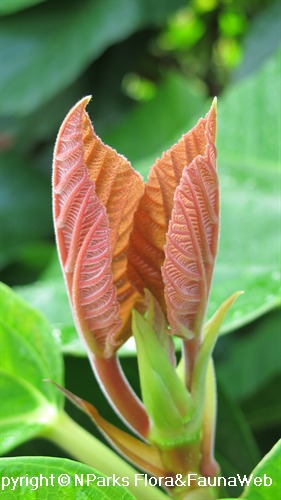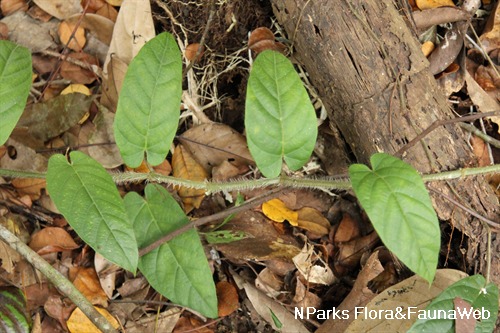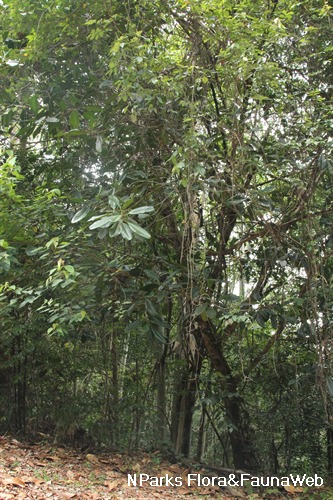
Back
Ficus auriculata Lour.
| Family Name: | Moraceae |
| Synonyms: | Ficus roxburghii |
| Common Name: | Broad-leaf Fig, Roxburgh Fig, Giant Indian Fig, Elephant Ear Fig Tree, Himalaya Fig Tree, Ara, Anjir, Kelebok, Nangtan, 大果榕 |
Name
Classifications and Characteristics
| Plant Division | Angiosperms (Flowering Seed Plants) (Dicotyledon) |
|---|---|
| Plant Growth Form | Tree (Shrubby (1m-5m)) |
| Lifespan (in Singapore) | Perennial |
| Mode of Nutrition | Autotrophic |
| Plant Shape | Umbrella |
| Maximum Height | 3 m to 5 m |
| Maximum Plant Spread / Crown Width | 5 m to 7 m |
Biogeography
| Native Distribution | Himalayas, Indian subcontinent, southern China, Indochina |
|---|---|
| Native Habitat | Terrestrial (Riverine) |
| Preferred Climate Zone | Sub-Tropical / Monsoonal |
Description and Ethnobotany
| Others - Plant Morphology | Small, non-strangling fig tree, with widely-spreading crown, low branching and short stout trunk. Injured surfaces produce cream-coloured latex. Leaves large (30x30cm), heart-shaped, prominently-veined, hairy underneath; young leaves pinkish-brown.Fleshy fruit-like structures (synconiums) produced in clusters directly on basal branches and trunk -- a phenomenon known as cauliflory. Synconiums large and hollow, bearing numerous tiny flowers on inner wall. Wild forms are divided into gall trees (male and gall flowers in same fig) and seed trees (female flowers), which are pollinated by fig wasps. Cultivated forms apparently parthenogenic, produce only female figs and are not visited by wasps. Synconiums ripen from reddish-brown to speckled reddish-purple, becoming fragrant, sweet and edible upon maturity.Likes well-drained soils rich in organic matter. Eye-catching large leaves make tree suitable as specimen plant in parks and large gardens. Species epithet 'auriculata' (meaning ear-like) describes shape of leaves or scales around fig's opening (ostiole). |
|---|---|
| Ethnobotanical Uses | Edible Plant Parts : Edible Fruits, Edible Leaves Food (Herb or Spice) (Fruit or Vegetable) Others: Young figs are quite tasteless, but either eaten raw with sambal belacan, or cooked with mutton curry. Ripe figs used to make jams. Infusion of leaves consumed in Malaysia to treat diabetes and high blood pressure. Young leaves used as fodder for cattle and other livestock. |
Landscaping Features
| Desirable Plant Features | Fragrant (Fruits), Ornamental Foliage, Ornamental Fruits |
|---|---|
| Landscape Uses | General, Focal Plant |
| Thematic Landscaping | Naturalistic Garden |
| Usage Hazard - Cons | Weak Branches, Low Crown / Clearance |
| Usage Hazard - Cons Remarks | Lower branches tend to break after storm due to weight of rainwater collected on large leaves. |
Fauna, Pollination and Dispersal
| Pollination Method(s) | Biotic (Fauna) (Associated with: Flowers pollinated by fig wasp (Ceratosolen emarginatus)., Insects (Ant, Beetle, Fly, Thrip, Wasp)) |
|---|
Plant Care and Propagation
| Light Preference | Full Sun |
|---|---|
| Water Preference | Moderate Water |
| Plant Growth Rate | Moderate |
| Rootzone Tolerance | Drought Tolerant, Fertile Loamy Soils, Well-Drained Soils |
| Propagation Method | Seed, Stem Cutting, Marcotting |
| Maintenance Requirements Remarks | Remove mature fruits from base of trunk, or else the rotted fruits will litter the ground below. |
| Planting Distance | 10 m |
Foliar
| Foliage Retention | Evergreen |
|---|---|
| Mature Foliage Colour(s) | Green |
| Mature Foliage Texture(s) | Velvety / Furry / Tomentose, Hairy / Hirsute, Raised / Sunken Veins, Thin |
| Prominent Young Flush Colour(s) | Red |
| Foliar Type | Simple / Unifoliate |
| Foliar Arrangement Along Stem | Alternate |
| Foliar Shape(s) | Non-Palm Foliage (Ovate) |
| Foliar Venation | Pinnate / Net |
| Foliar Margin | Entire - Wavy / Undulate |
| Foliar Apex - Tip | Acute |
| Foliar Base | Rounded / Obtuse |
| Typical Foliar Area | Macrophyll ( 182.25cm2 - 1640.25 cm2 ) |
| Leaf Area Index (LAI) for Green Plot Ratio | 3.0 (Tree - Intermediate Canopy) |
Non - Foliar and Storage
| Trunk Type (Non Palm) | Woody |
|---|---|
| Bark Colour(s) | Pale brown |
| Mature Bark Texture | Scaly, Smooth |
| Stem Type & Modification | Woody |
| Root Type | Underground (Tap Root, Fibrous Root) |
| Mature Bark Texture Remarks | Bark of young tree is smooth, becoming rougher as tree matures. |
Floral (Angiosperm)
| Flower & Plant Sexuality | Unisexual Flowers , Dioecious |
| Flower Colour(s) | Cream / Off-White |
|---|
| Flower Size - Remarks | Tiny and numerous, held on inner wall of synconium structure. |
| Inflorescence Type | Syconium |
| Flowering Period | Free-Flowering |
| Flowering Habit | Polycarpic |
Fruit, Seed and Spore
| Mature Fruit Colour(s) | Purple, Red |
|---|---|
| Fruit Classification | Simple Fruit |
| Fruit Type | Fleshy Fruit , Multiple Syconium (receptacle) |
Image Repository
Others
| Master ID | 1604 |
|---|---|
| Species ID | 2897 |
| Flora Disclaimer | The information in this website has been compiled from reliable sources, such as reference works on medicinal plants. It is not a substitute for medical advice or treatment and NParks does not purport to provide any medical advice. Readers should always consult his/her physician before using or consuming a plant for medicinal purposes. |

























.jpg)